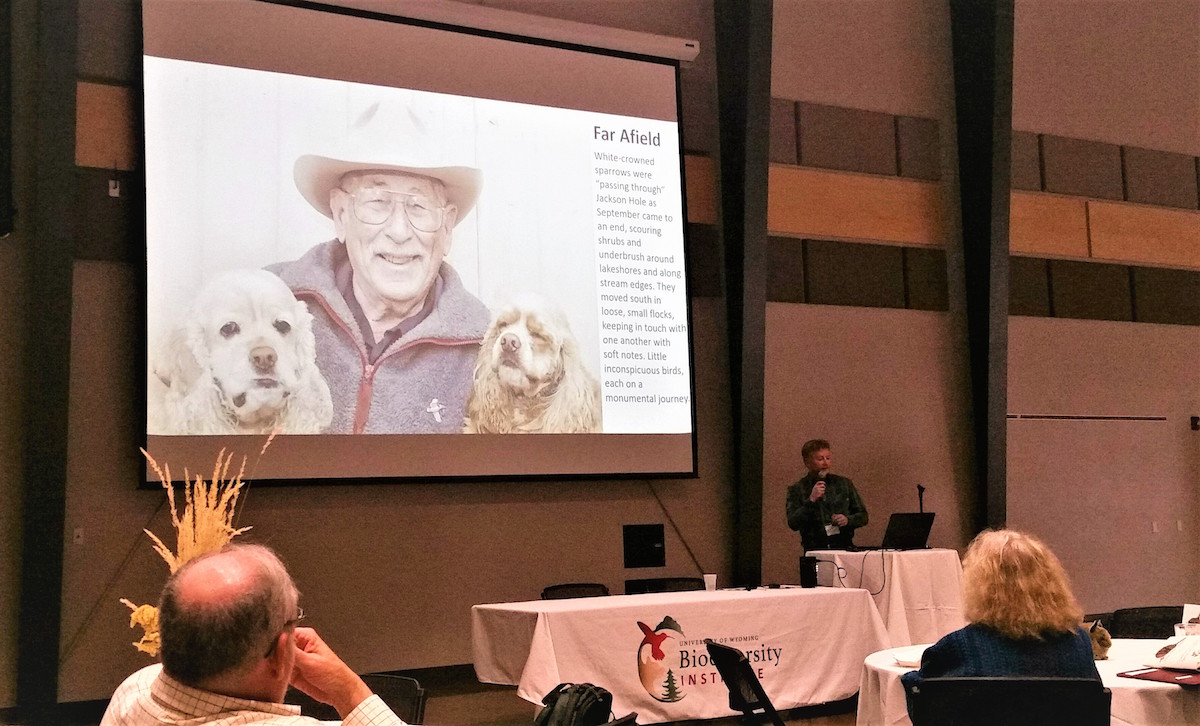
JHWF ED Jon Mobeck presents on the artistry of citizen science and the conservation legacy informing Nature Mapping Jackson Hole.
Earlier this month the University of Wyoming Biodiversity Institute hosted the first ever Wyoming Citizen Science Conference in Lander. Several representatives from the Jackson Hole Wildlife Foundation (JHWF) and Nature Mapping Jackson Hole (NMJH) attended the conference with the aim of learning from other citizen science practitioners across the state and of sharing what we have learned from the past eight years of running our program. The conference proved to be very valuable.
The variety of citizen science programs represented was immense and indicative of the breadth and depth available in Wyoming. For example, modeled on NMJH, Laramie sponsors both a winter and summer “Moose Day” with up to 38 transects and over 80 volunteers. Rocky Mountain Amphibian Project conducted a survey of chytrid fungus in frogs and toads throughout the state, including Teton County. A PhD student studied how geo-tagged imagery can enhance surveys by providing follow-up ID, unbiased assessments, and long-term documentation of plants and animals. Museums around the country are recruiting citizen scientists to review historical specimens, including label information on University of Wyoming herbarium sheets. Road Scholar (formerly Elderhostel) volunteers are chronicling archaeological sites in the Wind River Mountains. Associated with the North American Butterfly Association, twenty citizen scientists have tracked approximately 28 species of butterflies in a count circle in Lander for a decade. These are only a few of the amazing projects presented.
The core focus of the conference was on the problems and solutions that citizen science program managers and volunteers face. Several speakers talked about the difficulty of designing data sheets that capture essential information while also being user–friendly. Project directors need to enter and analyze data relatively quickly to keep citizen scientists engaged: volunteers are rewarded by seeing results of their work. Social occasions help build a concerned community. While ensuring quality remains challenging, with sufficient training citizen scientists produce solid scientific data. For instance, the Rocky Mountain Amphibian Project compared the quality of data collected by volunteers vs. bio-techs with very similar results. In short, presenters concluded, “Citizen scientists rock!” And we have a lot to learn from each other.
Our role in the conference:
On the whole, 65 conference participants came from across Wyoming, and even Idaho and Vermont too – all from a mix of individual citizen scientists, nonprofit organizations, primary and higher educational institutions and federal agencies.
JHWF was a silver-level sponsor for the Wyoming Citizen Science Conference, and our Associate Director Kate Gersh served on the program planning committee, which helped select presenters and set the agenda. Over the course of nearly two full days, here are a few programs that were presented by JHWF board, staff, and partners:
- “Lessons Learned: Eight Years of a Citizen Science Program in Jackson Hole” – Aly Courtemanch
- “Values Driving Conservation: Citizen Science as Interactive Art” – Jon Mobeck
- “Fundraising for Citizen Science: Experiences and Advice” – Kate Gersh, Anya Tyson, Wendy Estes-Zumpf, Frances Clark (in absence)
- Poster Presentation: Nature Mapping Jackson Hole: Mapping Community Solutions ̶ Kate Gersh
- Poster Presentation: Monitoring Wildlife Crossings on South Highway 89 ̶ Paul Hood
- “Bringing Citizen Science into the Backcountry: Emerging Best Practices to Engage Outdoor Education Organizations” – Anya Tyson
- Screening of Far Afield: A Conservation Love Story
Importantly, one of NMJH’s lead volunteers Tim Griffith attended the conference and contributed much to the conversation. Based on the latter and the abovementioned, we believe we successfully expanded awareness of Nature Mapping Jackson Hole statewide and regionally, thereby opening opportunities for greater community connections. This was a proud experience for us and we feel honored to have represented on behalf of everyone who has been involved with NMJH.
Next steps for Citizen Science
What comes next? Well, based on survey responses, conference participants have expressed a desire for open communication and collaboration between citizen science groups, as well as, one central location to list project information. The Biodiversity Institute is excited to share that they have begun the process of planning a website to act as a citizen science clearing house. It will provide a forum for discussion around citizen science projects in our region and to glean tips and ideas for best practice. It will also help to incorporate our projects into the classroom. In addition, the idea of a dedicated newsletter for citizen science groups in Wyoming is under discussion.
The hope is that this conference will take place again next year, giving us the opportunity to follow-up on tactics and ideas that were shared. We have much to learn still about volunteer recruitment and retention, fundraising, risk management, data collection and submission, data sharing and dissemination, evaluation and the list goes on. JHWF will be sure to keep you updated on new developments as they come about. Stay tuned as we continue to explore the potential of all that Nature Mapping Jackson Hole has to offer!
